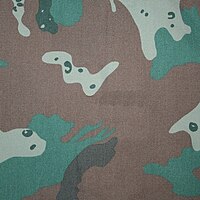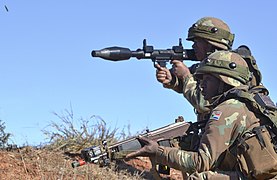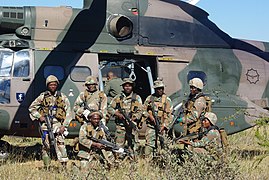
The Desert Battle Dress Uniform (DBDU) is a U.S. arid-environment camouflage battle uniform that was used by the United States Armed Forces from the early 1980s to the early to mid 1990s, most notably during the Persian Gulf War. Although the U.S. military has long since abandoned the pattern, it is still in widespread use by militaries across the world as of the early 2020s.

Flecktarn is a family of three-, four-, five- or six-color disruptive camouflage patterns, the most common being the five-color pattern, consisting of dark green, grey-green, red brown, and black over a light green or tan base depending on the manufacturer. The original German five-color pattern was designed for use in European temperate woodland terrain. A three-color variation called Tropentarn is intended for arid and desert conditions; the German Bundeswehr wore it in Afghanistan.

The Battle Dress Uniform (BDU) is a camouflaged combat uniform that was used by the United States Armed Forces as their standard combat uniform from the early 1980s to the mid-2000s. Since then, it has been replaced or supplanted in every branch of the U.S. Armed Forces.

The Army Combat Uniform (ACU) is the current combat uniform worn by the United States Army, U.S. Air Force, and U.S. Space Force. Within U.S. Air Force and U.S. Space Force, it is referred to as the OCP Uniform, rather than the Army Combat Uniform.

A combat uniform, also called field uniform, battledress or military fatigues, is a casual type of uniform used by military, police, fire and other public uniformed services for everyday fieldwork and combat duty purposes, as opposed to dress uniforms worn in functions and parades. It generally consists of a jacket, trousers and shirt or T-shirt, all cut to be looser and more comfortable than more formal uniforms. Design may depend on regiment or service branch, e.g. army, navy, air force, marines, etc. In the army branches, fabrics tend to come in camouflage, disruptive pattern or else green, brown or khaki monochrome, in order to approximate the background and make the soldier less visible in nature. In Western dress codes, field uniform is considered equivalent to civilian casual wear. As such, field uniform is considered less formal than service dress uniform, generally aimed at office or staff use, as well as mess dress uniform, and full dress uniform.
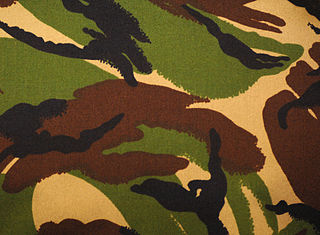
Disruptive Pattern Material (DPM) is the commonly used name of a camouflage pattern used by the British Armed Forces as well as many other armed forces worldwide, particularly in former British colonies.

Disruptive Pattern Camouflage Uniform (DPCU), also nicknamed Auscam, jelly bean camo, or hearts and bunnies is a five-colour military camouflage pattern used by the Australian Defence Force. Replacing the jungle greens used from WWII, it was developed and tested during the late 1970s and early 1980s. The uniform was trialled in 1987, with it being slowly introduced in late 1989, with the last production and discontinuation of the jungle greens being in late 1990. Jungle greens were last issued in late 1991 for Australian Regular Army, and late 1994 for Australian Army Reserve.

Tiger stripe is the name of a group of camouflage patterns developed for close-range use in dense jungle during jungle warfare by the South Vietnamese Armed Forces and adopted in late 1962 to early 1963 by US Special Forces during the Vietnam War. During and after the Vietnam War, the pattern was adopted by several other Asian countries. It derives its name from its resemblance to a tiger's stripes and were simply called "tigers." It features narrow stripes that look like brush-strokes of green and brown, and broader brush-strokes of black printed over a lighter shade of olive or khaki. The brush-strokes interlock rather than overlap, as in French Lizard pattern (TAP47) from which it apparently derives.

MultiCam is a camouflage pattern designed for use in a wide range of environments and conditions which was specifically developed and is produced by American company Crye Precision. As a result of the pattern's effectiveness across disparate environments and regions, it has found extensive adoption globally. Variants of it, some unlicensed, are in use with armed forces worldwide, particularly with special operations units.

The Desert Camouflage Uniform (DCU) is an arid-environment camouflage uniform that was used by the United States Armed Forces from the mid-1990s to the early 2010s. In terms of pattern and textile cut, it is identical to the U.S. military's Battle Dress Uniform (BDU) uniform, but features a three-color desert camouflage pattern of dark brown, pale olive green, and beige, as opposed to the four-color woodland pattern of the BDU. It replaced the previous Desert Battle Dress Uniform (DBDU) which featured a six-color "chocolate chip" pattern of beige, pale olive green, two tones of brown, and black and white rock spots. Although completely phased out of frontline use in the U.S. Armed Forces, some pieces and equipment printed in the DCU camouflage pattern are used in limited numbers such as MOPP suits and/or vests.

The Universal Camouflage Pattern (UCP) is a digital military camouflage pattern formerly used by the United States Army in their Army Combat Uniform. Technicians at Natick Soldier Systems Center attempted to devise a uniform pattern that would mask the wearer in all seasonal environments. Laboratory and field tests from 2003 to 2004 showed a pattern named "All-Over-Brush" to provide the best concealment of the patterns tested. All-Over-Brush was selected as the winner over ten other patterns. The disadvantage of an all-in-one pattern is that it is a combination of what is effective in many different environments and is less effective in a particular environment when compared to a specialized coloration designed specifically for that environment. The winning All-Over-Brush pattern was not used as the final UCP. Instead, U.S. Army leadership utilized pixellated images taken from Canadian CADPAT and US Marine Corps MARPAT, then recolored them based on three universal colors developed in the Army's 2002-2004 tests, to be called the UCP. While the pixelated pattern of the UCP is similar to the MARPAT and CADPAT camouflage patterns used by the United States Marine Corps and the Canadian Armed Forces, its coloration differs significantly. The final UCP was then adopted without field testing against other patterns.

The lizard pattern is a family of many related designs of military camouflage pattern, first used by the French Army on uniforms from 1947 to the late 1980s. It was based on the British paratroopers' Denison smock. The use of the pattern is widespread in Africa, despite its association with France, because armed factions and militaries tend to obtain them from whichever source has it available.

The ERDL pattern, also known as the Leaf pattern, is a camouflage pattern developed by the United States Army at its Engineer Research & Development Laboratories (ERDL) in 1948. It was not used until the Vietnam War, when it was issued to elite reconnaissance and special operations units beginning early 1967.

The Camouflage Central-Europe is the standard camouflage pattern of the French Armed Forces.

Canadian Disruptive Pattern is the computer-generated digital camouflage pattern developed for use by the Canadian Armed Forces. Four operational variations of CADPAT have been used by the Canadian Armed Forces: a temperate woodland pattern, an arid regions pattern, a winter operations pattern, and a multi-terrain pattern.
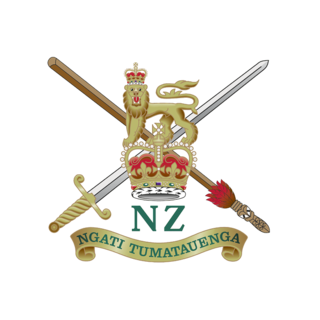
The New Zealand Army uniform has changed over the years from that of the original Armed Constabulary of the 1800s to the modern Army Combat Uniform style in use by the majority of world armies today. While British Army influence has always been strong, distinctive New Zealand features have gradually developed. From 2013 the New Zealand Army uniform underwent a complete redesign with a new and distinctive camouflage pattern unique to the NZDF.

Operational Camouflage Pattern (OCP), originally codenamed Scorpion W2, is a military camouflage pattern adopted in 2015 by the United States Army for use as the U.S. Army's main camouflage pattern on the Army Combat Uniform (ACU). This pattern officially replaced the U.S. Army's previous Universal Camouflage Pattern (UCP) as the official combat uniform pattern for most U.S. soldiers at the end of September 2019. The pattern also superseded the closely related MultiCam, a pattern previously used for troops deploying to Afghanistan.

Xingkong, is a military camouflage pattern adopted in 2019 by all branches of the People's Liberation Army (PLA) of the People's Republic of China (PRC). Introduced in 2019, the Xingkong pattern replaced the Type 07 camouflage on the Type 07 service uniforms used by regular units. The new uniform and Xingkong camouflage were first seen in late September 2019 before the celebration ceremony for the 70th anniversary of the People's Republic of China.

The Netherlands Fractal Pattern (NFP) was developed as a collaboration project between the Netherlands Organisation for Applied Scientific Research (TNO) and the Dutch Ministry of Defence in order to replace all the camouflage patterns in use by the Dutch military.

EMR ; or Universal Camouflage Colourway in English, is a military camouflage pattern in use by the Russian Armed Forces. It is sometimes referred to by the unofficial nicknames RUSPAT, Tetris, Tsifra and Digital Flora. EMR camouflage is the standard camouflage pattern of the Russian Military's VKBO All-Season Uniform.
